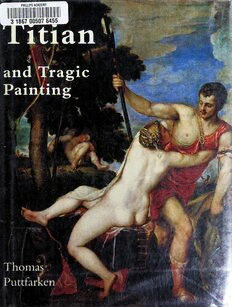
Titian & tragic painting : Aristotle's Poetics and the rise of the modern artist PDF
Preview Titian & tragic painting : Aristotle's Poetics and the rise of the modern artist
PHILLIPS ACAO 3 1867 00507 6455 Titian and Tragic Painiing Thomas' Puttfarken TITIAN AND TRAGIC PAINTING • * C- > ” ■ · * Painting Aristotle’s Poetics and the Rise of the Modern Artist Thomas Puttfarken Late in his life Titian created a series of paintings - the ‘Four Sinners’, the ‘poesie’ for his patron Philip n of Spain, and the ‘Final Tragedies’ - that were dark in tone and content, full of pathos and physical suffering. In this major reinterpretation ofTitian’s art, Thomas Puttfarken shows that the often dramatic and violent subject matter of these works was not, as is often argued, the consequence of the artist’s increasing .uB and sense of isolation and tragedy. Rather, these paintings were influenced by discussions of Aristotle’s Poetics that permeated learned discourse in Italy in the mid-sixteenth century. The Poetics led directly to a rich theory of the visual arts, and painting in particular, that enabled artists like Titian to consider themselves on equal footing with poets. Puttfarken- investigates Titian’s late works in this context and analyses his relations with his patrons, his intellectual and humanistic contacts and his choices of subject matter, style and technique. I* a ·.·“ . ' .< : Phillips Academy ANDOVER, MASSACHUSETTS FROM THE FUND ESTABLISHED IN MEMORY OF Fred Tomsley Murphy, p.a. ’93, yale’97 TRUSTEE OF PHILLIPS ACADEMY, I908-I948 TRUSTEE OF YALE UNIVERSITY 1919-I94O TITIAN & TRAGIC PAINTING TITIAN & TRAGIC PAINTING Aristotle’s Poetics and the Rise of the Modern Artist THOMAS PUTTFARKEN Yale University Press ~ New Haven and London Copyright © 2005 by Thomas Puttfarken All rights reserved. This book may not be reproduced, in whole or in part, in any form (beyond that copying permitted by Sections 107 and 108 of the U.S. Copyright Law and except by reviewers for the public press), without written permission from the publishers. Designed by Laura Bolick Printed in China Library of Congress Cataloging-in-Publication Data Puttfarken, Thomas. Titian and tragic painting : Aristotle's 'poetics' and the rise of the modern artist / Thomas Puttfarken. p. cm. Includes bibliographical references and index. ISBN 0-300-11000-6 (cl : alk. paper) 1. Titian, ca. 1488-1576 - Criticism and interpretation. 2. Tragic, The, in art. 3. Ut pictura poesis (Aesthetics) 4. Aristotle - Influence. 5. Painting, Renaissance - Italy. 6. Painters - Italy - Social conditions - History - 16th century. I. Title. ND623.T7P87 2005 759.5 - dc22 2005012042 A catalogue record for this book is available from The British Library Frontispiece: Titian: Diana and Actaeon, 1556-59 (detail), oil on canvas, 198 x 206 cm, National Gallery of Scotland, Edinburgh (Duke of Sutherland loan) CONTENTS Acknowledgements vi Introduction i PART I: ON THE STATUS OF PAINTING IN THE RENAISSANCE i Painting, Poetry and the Liberal Arts 15 2 Imitation, Moral Purpose and Learning 41 3 Tragedy 57 PART II: TITIAN AND TRAGEDY 4 The Four Great Sinners 77 5 Michelangelo and Titian: Terribilità and Tragic Pathos 97 6 Titian's Mythological Paintings: Problems of Interpretation 129 7 Titian's poesie for Philip 11 as Painted Tragedies 155 8 The Final Tragedies and Titian's 'Late Style' 183 Notes 205 Bibliography 225 Index 234 Photograph Credits 240 ACKNOWLEDGEMENTS This book grew out of lectures and seminars on Titian's art and on the social status of the artist in the Renaissance to which I have subjected my students at Essex for many years. The specific attempt to read Titian's mythological paintings in the light of six teenth-century discussions of Aristotle's Poetics led to a paper which I delivered between 1998 and 2002 at several universities in Britain and abroad. For the purposes of its central argument the book was ready for publication in 2002, yet it was held up by the promise of seeing together many of the pictures discussed in it on the occasion of the great Titian exhibitions of 2003, at the National Gallery in Eondon and the Prado in Madrid. I hope the book will have benefited from the delay. Over the years I have discussed aspects and problems of this project with many friends, colleagues and students. As always I am greatly indebted to my fellow members of the Department of Art History and Theory at Essex for their criticism and support. For various contributions I owe thanks to Dawn Ades, Libby Armstrong, Caterina Badan, Gottfried Boehm, Richard Cocke, Neil Cox, Elly Crichton Stuart, David Davies, Kate Dunton, Valerie Fraser, Michaela Giebelhausen, Margaret Iversen, Ludmilla Jordanova, Lubomir Konecny, Tim Laughton, Jules Lubbock, Liz McGrath, John Nash, John Onians, Deborah Povey, Pat Rubin, Wilhelm Schlink, Susan Siegfried, Sarah Symmons, Paul Taylor, Peter Vergo, and Lisa Wade. Above all I am grateful to Paul Hills and Michael Podro for their immensely helpful comments on earlier drafts. My research has been generously supported by grants from the British Academy, the AHRB (now AHRC), and the University of Essex Research Promotion Fund. I am most grateful for their financial assistance. To work with Gillian Malpass and Laura Bolick at Yale University Press has been a privilege and great pleasure. vi
